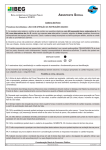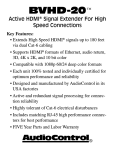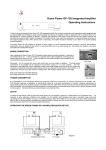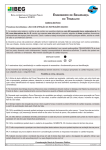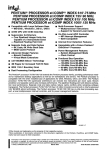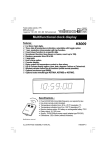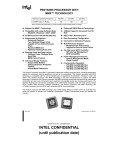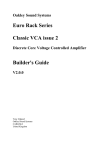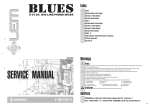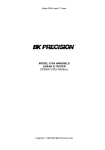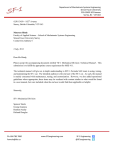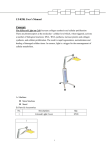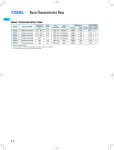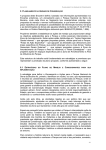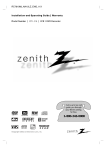Download Manual - Velleman
Transcript
Total solder points: 500 Difficulty level: beginner 1o 2o 3o 4o 5þ advanced HIGH-END CONTROL AMPLIFIER K8021 ILLUSTRATED ASSEMBLY MANUAL H8021IP-1 VELLEMAN KIT NV Legen Heirweg 33 9890 Gavere Belgium http://www.velleman.be Assembly hints 1. Assembly (Skipping this can lead to troubles ! ) Ok, so we have your attention. These hints will help you to make this project successful. Read them carefully. 1.1 Make sure you have the right tools: • A good quality soldering iron (25-40W) with a small tip. • Wipe it often on a wet sponge or cloth, to keep it clean; then apply solder to the tip, to give it a wet look. This is called ‘thinning’ and will protect the tip, and enables you to make good connections. When solder rolls off the tip, it needs cleaning. • Thin raisin-core solder. Do not use any flux or grease. • A diagonal cutter to trim excess wires. To avoid injury when cutting excess leads, hold the lead so they cannot fly towards the eyes. • Needle nose pliers, for bending leads, or to hold components in place. • Small blade and phillips screwdrivers. A basic range is fine. For some projects, a basic multi-meter is required, or might be handy 0.0 00 1.2 Assembly Hints : ⇒ Make sure the skill level matches your experience, to avoid disappointments. ⇒ Follow the instructions carefully. Read and understand the entire step before you perform each operation. ⇒ Perform the assembly in the correct order as stated in this manual ⇒ Position all parts on the PCB (Printed Circuit Board) as shown on the drawings. ⇒ Values on the circuit diagram are subject to changes. ⇒ Values in this assembly guide are correct* 3 Assembly hints ⇒ Use the check-boxes to mark your progress. ⇒ Please read the included information on safety and customer service * Typographical inaccuracies excluded. Always look for possible last minute manual updates, indicated as ‘NOTE’ on a separate leaflet. 1.3 Soldering Hints : 1- Mount the component against the PCB surface and carefully solder the leads 2- Make sure the solder joints are coneshaped and shiny 3- Trim excess leads as close as possible to the solder joint AXIAL COMPONENTS ARE TAPED IN THE CORRECT MOUNTING SEQUENCE ! REMOVE THEM FROM THE TAPE ONE AT A TIME ! 4 P E Aran- Giallo Verde Blu Viola Grigio Bianco 3 4 5 6 7 8 9 Naran- Oranssi Brun Svart Orange Blå Grön Kulta B Oro Dourado Oro Grå Guld Silver Valkoinen Vit Hopea Blanco Harmaa A Argento Prateado Plata Branco Sininen Vihreä Morado Purppura Lila Azul Verde Cinzento Gris Violeta Azul Verde S DK 4K7= ( 4 - 7 - 0 - 1 - 1 ) 1% N Rød Brun Sort Guld Sølv Hvid Grå Violet Blå Grøn Gul Guldl Sølv Hvidt Grå Violet Blå Grønn Gul Orange Orange Rød Brun Sort FÄRG FARVE- FARGESCHEMA KODE KODE Punainen Röd Ruskea Musta VÄRI KOODI SF Amarelo Amarillo Keltainen Gul Laranja Rojo Rosso 2 Encar- Marrone Castanho Marrón Negro 1 Preto Nero 0 C CODICE CODIGO CODIGO O COLORE DE DE D CORES COLORE E S I 4K7= ( 4 - 7 - 2 - B ) 5% GB F NL Gold Silber Weiss Grau Violet Blau Grün Gelb Orange Rot Braun Gold Silver White Grey Purple Blue Green Yellow Orange Red Brown Schwarz Black Or Argent Blanc Gris Violet Blue Vert Jaune Orange Rouge Brun Noir 2 1 0 4 Goud Zilver Wit Grijs B A 9 8 Paars 7 Blauw 6 Groen 5 Geel Oranje 3 Rood Bruin Zwart FARB COLOUR CODIFI- KLEUR C KODE CODE CATION KODE O D DES E COU- D COLOR= 2… 5 Color code table 5 Construction CONSTRUCTION The unit consists out of two PCB’s, one is the main PCB, P8021B and the other is the left channel input section P8021L. First we will start with the small P8021L, then we assemble the P8021B. FTip: The pictures on the packaging can be used as a guideline. However, due to possible changes it is not 100% reliable. P8021L 1. Diodes (check the polarity) 2. Resistors (check the color code) D... CATHODE q q q q q q 6 D1: 1N4148 D2: 1N4148 D3: 1N4148 D4: 1N4148 D5: 1N4148 D6: 1N4148 R... q q q q q q q q R1: 10K (1-0-3) R2: 10K (1-0-3) R3: 10K (1-0-3) R4: 10K (1-0-3) R5: 10K 1-0-3) R6: 10K (1-0-3) R7: 1K (1-0-2) R8: 330R (3-3-1) Construction 3. Capacitors 6. RCA connectors. Mount them straight and against the PCB C... q q q q q q C1: 220p (221) C2: 220p (221) C3: 220p (221) C4: 220p (221) C5: 220p (221) C6: 220p (221) 4- Reed relays (check the position q q q q q q SK1: MJ-523AG/B BLACK SK2: MJ-523AG/B BLACK SK3: MJ-523AG/B BLACK SK4: MJ-523AG/B BLACK SK5: MJ-523AG/B BLACK SK6: MJ-523AG/B BLACK of the notch) 7. Pin connector. Mount it exactly as indicated RY... q q q q q q RY1: VR05051AS or eq. RY2: VR05051AS or eq RY3: VR05051AS or eq RY4: VR05051AS or eq RY5: VR05051AS or eq RY6: VR05051AS or eq. 5. transistors q SK7: HDR20/26 q q q q q q T1: BC557 T2: BC557 T3: BC557 T4: BC557 T5: BC557 T6: BC557 7 Construction P8021B Assembly 8 Construction 1. Jump wires 3. Zener diode (check the polarity) ZD... CATHODE q ZD1: 20V / 0.6W q J1... J25 4. Resistors (check the color code) 2. Diodes (check the polarity) D... R... CATHODE q q q q q q q q q q q q q q q q D1: 1N4148 D2: 1N4148 D3: 1N4148 D4: 1N4148 D5: 1N4148 D6: 1N4148 D7: 1N4148 D8: 1N4148 D9: 1N4007 D10: 1N4007 D11: 1N4007 D12: 1N4007 D13: 1N4007 D14: 1N4007 D15: 1N4007 D16: 1N4007 q q q q q q q q q q q q q q q q q q q q q R1: 10K (1-0-3) R2: 10K (1-0-3) R3: 10K (1-0-3) R4: 10K (1-0-3) R5: 10K (1-0-3) R6: 10K (1-0-3) R7: 10K (1-0-3) R8: 10K (1-0-3) R9: 47K (4-7-3) R10: 470R (4-7-1) R11: 620R/1% (6-2-0-0) R12: 33R (3-3-0) R13: 33R (3-3-0) R14: 390K/1% (3-9-0-3) R15: 33K/1% (3-3-0-2) R16: 1K (1-0-2) R17: 47K (4-7-3) R18: 470R (4-7-1) R19: 620R/1% (6-2-0-0) R20: 390K/1% (3-9-0-3) R21: 33K/1% (3-3-0-2) 9 Construction q R22: 1K (1-0-2) q R23: 560R/1% (5-6-0-0) q R24: 1K8/1% (1-8-0-1) q R25A or R25B: 1K5 (1-5-0-1) (*) q R26: 1K5 (1-5-2) q R27: 560R/1% (5-6-0-0) q R28A or R28B: 1K5 (1-5-2) (*) * The position of R25 and R28 depends on the supplied IC for IC2 and IC3: Mount R25B and R28B if type OPA134 is supplied. Mount R25A and R28A. If types OPA604 or TLE2071 are supplied. q q q q q q q q q q q q q q q q q q q q q q q q q 10 R29: 1K8/1% (1-8-0-1) R30: 1K5 (1-5-2) R31: 56R (5-6-0) R32: 56R (5-6-0) R33: 1K (1-0-2) R34: 330R (3-3-1) R35: 1R (1-0-0) R36: 1R (1-0-0) R37: 1R (1-0-0) R38: 1R (1-0-0) R39: 1K/1% (1-0-0-1) R40: 1K/1% (1-0-0-1) R41: 1K (1-0-2) R42: 1K (1-0-2) R43: 1K (1-0-2) R44: 1K (1-0-2) R45: 10K (1-0-3) R46: 10K (1-0-3) R47: 10K (1-0-3) R48: 10K (1-0-3) R49: 10K (1-0-3) R50: 4K7 (4-7-2) R51: 1R (1-0-0) R52: 470R (4-7-1) R53: 1K5 (1-5-2) 5. Choke L... L... q L1: 1uH (1-0) q L2: 1uH (1-0) 6. IC sockets q q q q IC1: 8P IC2: 8P IC3: 8P IC4: 18P 7. Female header SK.. J... q SK7: 20P (type 96120205) Construction 8. Capacitors 9. Reed relays (check the position of the notch) C... RY... q q q q q q q q q q q q q q q q q q q q q q q q q q q q q q q C1: 220p (221) C2: 220p (221) C3: 220p (221) C4: 220p (221) C5: 220p (221) C6: 220p (221) C7: 220p (221) C8: 220p (221) C9: 220p (221) C10: 2n2 (222, 2200) C11: 2n2 (222, 2200) C12: 8n2 (822, 8200) C13: 8n2 (822, 8200) C14: 100n (104, 0.1, u1) C15: 100n (104, 0.1, u1) C16: 100n (104, 0.1, u1) C17: 100n (104, 0.1, u1) C18: 100n (104, 0.1, u1) C19: 100n (104, 0.1, u1) C20: 100n (104, 0.1, u1) C21: 100n (104, 0.1, u1) C22: 100n (104, 0.1, u1) C23: 100n (104, 0.1, u1) C24: 100n (104, 0.1, u1) C25: 100n (104, 0.1, u1) C26: 100n (104, 0.1, u1) C27: 100n (104, 0.1, u1) C28: 100n (104, 0.1, u1) C29: 100n (104, 0.1, u1) C30: 2.2uF C31: 2.2uF q q q q q q q q RY1: VR05051AS or eq. RY2: VR05051AS or eq RY3: VR05051AS or eq RY4: VR05051AS or eq RY5: VR05051AS or eq RY6: VR05051AS or eq. RY7: VR05051AS or eq. RY8: VR05051AS or eq. 10. Pin header connector, cut at the indicated 5 pins 5 q SK8: 5P q SK9: 5P 11 Construction 11. transistors q q q q q q q q T1: BC557 T2: BC557 T3: BC557 T4: BC557 T5: BC557 T6: BC557 T7: BC557 T8: BC557 13. Push button Mount them straight against the PCB surface ! q q q q q SW1: TS-04PV SW2: TS-04PV SW3: TS-04PV SW4: TS-04PV SW5: TS-04PV Remark: The metal part of these buttons are used as jump wire. Be sure not to test or use the unit without soldering these push buttons. 12. Trim potentiometer 14. Phone jack. Mount him straight against the PCB surface ! L' SK.. q RV1: 100K q RV2: 100K J... q SK13: JCF3.5 (3.5mm jack) 12 R R' L Construction 15. RCA connectors. Mount them straight and against the PCB 17. Voltage regulator. The back side corresponds to the thick line. VR... q q q q q q SK1: MJ-523AG/R RED SK2: MJ-523AG/R RED SK3: MJ-523AG/R RED SK4: MJ-523AG/R RED SK5: MJ-523AG/R RED SK6: MJ-523AG/R RED q VR1 UA7815 q VR2 UA7915 q VR3 UA7805 16. Electrolytic capacitors. Check the polarity ! 18. Transformer. C... q q q q q q q q q q q q q q q q C32: 47µ C33: 47µ C34: 100µ C35: 100µ C36: 100µ C37: 470µ C38: 470µ C39: 470µ C40: 470µ C41: 470µ C42: 1000µ C43: 1000µ C44: 1000µ C45: 1000µ C46: 1000µ C47: 1000µ TRANSFORMER q TR1: TR8021, 9V-2x18V/ 6VA 13 Construction 19. Volume potentiometer. RV... q RV3: STRK27103 (2x50K ALPS) CAUTION: This is a high quality potentiometer, handle it with care. Follow the mounting instructions exactly and in order! 1.Mount the support bracket onto the potentiometer. Tighten the nut carefully. 2.Mount the potentiometer onto the PCB, using two 6mm (0.23”) screws and M3 nut. Only slightly tighten the nuts ! Do not solder the potentiometer connections yet ! 20. Mains voltage selection Use a piece of isolated brown wire to select the mains (outlet) voltage, as indicated on the PC board. q For 115Vac (100 to 120Vac) A jumper between A-B, and a jumper between C-D. A B C D q For 230Vac (220 to 240Vac) A jumper between B-C. B C Using a black marker, erase the not used voltage at the back of the unit. 21. Mains voltage connection preparation q Connect a 10cm blue wire to the point N of SK12. q Connect a 10cm brown wire to the point L of SK12. q Connect a 10cm yellow/green wire to the earth point of SK12. Later these connection will be soldered to the mains connector. 14 Construction 22. Mounting the LED’s. Check the polarity ! Short lead = Cathode or— ! CAUTION: After bending the leads the long appearing lead will be the cathode! LD... CATHODE First: Bend the leads exactly like the drawing. IMPORTANT Mount these LED’s exactly like in the Next: Solder one lead, and check the drawing, otherwise some LED’s will position, if necessary correct by heat- not fit correctly in the front panel. ing the soldering. Please also use the front panel as a positioning reference. Last: Solder the second connection. 3mm q LD7 L-424YDT FIG. 1 C q q q q q q 3mm LD1 L-424YDT LD2 L-424YDT LD3 L-424YDT LD4 L-424YDT LD5 L-424YDT LD6 L-424YDT 12mm C FIG. 2 7mm q LD8 L-424YDT FIG. 3 15 Construction 23. Mounting the sub PCB support q Mount four 2cm (0.8”) M3 spacers at the indicated positions using four 6mm (0.23”) M3 screws. 16 Enclosure preparation 24. Enclosure preparation q Cut the thread in the holes for the enclosure feet in one of the aluminum profiles, using the supplied special M4 screw as a tap. FIG. 1 q Mount the Feet on the aluminum profile, using two M4 hexagonal Allen screws. Use the supplied Allen wrench. It is advisable to stick the protection adhesive onto the feet. FIG. 2 q Cut the thread in the front and back of the aluminum profiles, using the supplied special M4 screw (4 holes per piece) FIG. 3 q Cut the thread in the back panel phono ground screw position, using the supplied special M3 screw. FIG. 4 17 Enclosure preparation q Position the main PCB in the aluminum profile that is prepared with the feet. The potentiometer must be at the same side of the feet. FIG. 5 Align pcb with profile ! q Mark the center position of the three fixation holes on the aluminum. 18 Enclosure preparation q Remove the pcb and use a knife or a screwdriver to scratch the paint from the aluminum fixation, from the hole closest to the back end. This fixation will be used later to connect the ground and earth. FIG. 6 q Mount the 3, 5mm (0.14”) spacers like FIG. 7 in the drawing. Using three hexagonal screws and a 5mm M3 spacer washer. Do not tighten the spacers yet. M3 hex. nut Washer q Position the PCB in the enclosure and check if the position of the spacers is correct, if so, remove the PCB and tighten the spacers. FIG. 8 0.0 00 q Using an ohmmeter, measure between the edge of the aluminum profile and the back spacer, if there is a good electric contact (0 ohm). If not, repeat the above step to remove the paint under the spacer. 19 Final assembly 25. Potentiometer assembly and final PCB mount q Mount the PCB into the enclosure like before. Tip: Check if the pcb does not have to much play at the potentiometer posiPlay? tion. If there is too much play, put a piece of tape round the edge of the pcb to remove FIG. 1 the slack. q Fix the pcb using a 5mm spacers next to C36. FIG. 2 q Mount the knob onto the potentiometer. (check the notch position) MAX FIG. 3 FUse the supplied Allen wrench MIN 20 Final assembly q Now carefully mount the front panel, using two M4 Allen screws. Check the position of the LED’s. q Check if the potentiometer turns smoothly without touching the front panel, otherwise correct his position or the position of the front panel. q Check if the phones connector (metal part) does not touch the front panel. FIG. 4 F Use the supplied Allen wrench q Remove the front panel and fix the nuts of the potentiometer bracket. q Remove the PCB from the enclosure and solder the potentiometer connections. q Again mount the pcb into the enclosure. q Fix the pcb using a 2cm (0.8”) spacer at the position next to SK7 and use 5mm spacers to fix the other two positions. Measure, using an ohm meter (or continuity beeper) if the 2cm spacer is electrically connected to the ground wire (yellow green wire). If not, recheck if the paint of the aluminum is correctly removed. FIG. 5 SPACER q Mount the left channel PCB onto the spacers, check that the connector is correctly inserted. Fix the PCB using five 6mm M3 screws. FIG. 6 21 Final assembly 26. Final assembly and connection q Mount (insert) the mains connector onto the rear panel. Insert a 250mA fuse into the connector (there is also room for a spare fuse). q Mount the rear panel onto the enclosure, using two M4 Allen screws. FIG. 1 q Mount the plastic phono ground screw onto the back panel. q Connect the mains wires to the mains connector, Blue= Neutral, Brown= Live, and green/yellow= Earth. Use a piece of 1.5cm (0.6”) shrink tube to isolate each connection. FIG. 2 q Mount the front panel onto the front, using two M4 Allen screws. FCheck the position of the LED’s and check if all buttons are working correctly. It could be that paint rest over in the holes, is preventing the buttons from smooth operation. FIG. 3 22 Test and adjustment 27. Test and adjustment Connect the mains AC voltage to the mains connector. Check if the power LED (in the center of the PCB) is lit. This means that the +15V and –15V are correct. ! CAUTION: Some points on the PCB are connected to the dangerous mains voltage. Disconnect the mains plug. Now insert the IC’s into their sockets: q q q q IC1 NE5532 IC2 TLE2071 / OPA134 / OPA604 IC3 TLE2071 / OPA134 / OPA604 IC4 VK8021 / PIC16C54RC Offset adjustment: It is important that the output of the amplifiers are free of DC voltage therefore the offset voltage needs adjustment: 1. 2. 3. 4. 5. Connect the unit to the mains. Push the CD input selector button, the corresponding LED should lit. Push and hold the CD input selector button, the +6dB LED should lit. Use a multimeter and set it to the lowest voltage range (2Vdc or lower). Measure between GND (the metal bracket of the potentiometer can be used) and J8 (Left channel offset adjustment). 6. Adjust the offset trimmer (next to IC2) until the meter indicates around 0V 7. Measure at point J9 (Right channel offset adjustment). 8. Adjust the offset trimmer (next to IC3) until the meter indicates around 0V Check the user manual to test all functions and operation of the unit, then the cover aluminum can be mounted. Please note that the user manual is also used for the ready assembled version. Some remarks may not be related to the kit version. 23 Diagram LINE JP5 SK1 PU/LINE +15V SK8 LINE PU PU R12 33R SK9 PU RY1 R10 R9 C35 +5V C1 -15V Input2 10K 390K/1% C12 33K/1% C11 C32 8n2 2n2 47µ SK7 +5V C3 BC557 220p D3 T3 1N4148 R3 R22 1K BC557 2.2uF Input1 Input2 3 Input3 Input4 R23 Monitor R39 1K/1% 1N4148 1K5 C17 -15VL Input4 10K R26 R24 1K8/1% RY8 D8 R4 6 IC2 2 560R/1% Mute +5V BC557 T8 1N4148 SK5 MONITOR 100n R8 RY5 +6dB R33 10K 1K BC557 C5 T5 RV3B 2.2uF C18 50K Monitor 10K R28B TLE2071 / OPA134 / OPA604 3 R34 IC3 R27 +5V 330R BC557 R29 1K8/1% C19 -15VR T6 100n R7 R6 1N4148 R40 1K/1% 5 1N4148 D6 D7 4 RY7 T7 +5V BC557 6 2 560R/1% RY6 220p RV2 100K 8 1 7 SK6 LINE OUT R 1K5 R28A 100n R5 1N4148 +15VL -15VR 1K5 +15VR Mount R28B for OPA134 else R28A C31 D5 Line out L +5V 220p 10K Mute 10K +6dB R30 1K5 L1 1uH R31 56R C7 SK13 220p L2 1uH RIGHT INPUT / OUTPUT SECTION AMPLIFIER SECTION 24 R25B 100n 50K T4 100K R25A 1K5 RV1 C16 RV3A 5 D4 C30 Line out L 4 220p TLE2071 / OPA134 /OPA604 -15VL +15VL +15VL 8 +5V C4 Mount R25B for OPA134 else R25A 20 19 18 17 16 15 14 13 12 11 10 9 8 7 6 5 4 3 2 1 1 7 Input3 10K RY4 C6 C10 R20 IC1B R21 R2 RY3 SK4 REC 100n 2n2 T2 1K 100µ R15 47µ D2 R19 33K/1% C33 C15 R13 33R R16 390K/1% 4 C34 BC557 C13 8n2 +5V 1N4148 7 R14 IC1A 6 620R/1% R11 620R/1% Input1 C2 SK3 TUNER 5 1 10K 220p NE5532 2 R1 RY2 LINE JP5 NE5532 3 T1 1N4148 R18 470R 8 47K D1 R17 47K C14 100n 470R 100µ BC557 220p SK2 CD PU LINE R32 56R C8 220p © Velleman Kit 1K5 Diagram R35 +15VL +15VR UA7815 O I 1R 470µ R53 1K5 C26 LD8 D9 1N4007 D10 100n 1000µ O 1R C44 C46 1000µ GND 100n I UA7915 VR2 VR3 UA7805 O I +5V C28 100µ 100n 1N4007 1N4007 D12 18 9 0 2 115 18 0 9 4 6 D13 D15 D14 1N4007 1N4007 D16 0 10 100n 8 C21 7 SK10 A B C D 0 115 TR8021 5 SK11 R52 SK12 1N4007 1N4007 N L MAINS GND C36 C22 1 470R -15V 1R Mains selection 100n D11 C23 ZA20V L-424YDT 1000µ -15VR R37 R38 C45 ZD1 C25 470µ 470µ -15VL C42 1N4007 C47 TR1 100n 1000µ C40 C24 100n 470µ R51 1R C38 VR1 1000µ C43 1000µ C41 GND C39 +15V 1R R36 C27 C37 C29 100n 470µ 100n 230V 115V B+C A+B C+D SK14 FASTON To Cover POWER SUPPLY SECTION +5V R44 1K R43 1K R42 1K +5V R41 1K R50 4K7 LD1 C9 LD7 10K 10K 10K Monitor 10K Mute 10K +6dB 5 Input4 16 3 4 2 6 7 8 11 IC4 OSC1/CLKIN OSC2/CLKOUT T0CKI RA1 MCLR/VPP RA0 RA3 RB7 RB0 RB6 RB1 RB3 RB2 RB4 RB5 RA2 PIC16C54RC VSS Input3 100n 220p +5V R49 R48 R45 R46 R47 C20 SW4 14 VDD Input2 L-424YDT LD6 L-424YDT L-424YDT LD4 L-424YDT L-424YDT LD2 L-424YDT L-424YDT Input1 LD5 LD3 15 18 17 13 12 9 10 1 REC SW3 TUNER SW2 CD SW1 PU/LINE SW5 STBY / MUTE CONTROLLER SECTION © Velleman Kit 25 Diagram PU/LINE RY1 SK1 +5V C1 BC557 220p D1 T1 1N4148 CD R1 10K RY2 SK2 +5V C2 BC557 220p D2 T2 SK7 1N4148 TUNER R2 10K RY3 SK3 +5V C3 BC557 220p D3 T3 1N4148 REC R3 10K RY4 SK4 +5V C4 +5V 20 19 18 17 16 15 14 13 12 11 10 9 8 7 6 5 4 3 2 1 BC557 220p D4 T4 1N4148 R4 10K MONITOR RY5 R7 SK5 1K BC557 C5 +5V 220p D5 T5 R5 1N4148 10K LINE OUT L R8 SK6 330R C6 RY6 220p +5V BC557 D6 1N4148 T6 R6 10K LEFT INPUT SECTION © Velleman Kit 26 Notes NOTES: 27 VELLEMAN KIT NV Legen Heirweg 33 9890 Gavere Belgium Europe Info ?: http://www.velleman.be Questions ?: [email protected] Modifications and typographical errors reserved © Velleman Kit nv H8021IP - 2000 - ED1





























